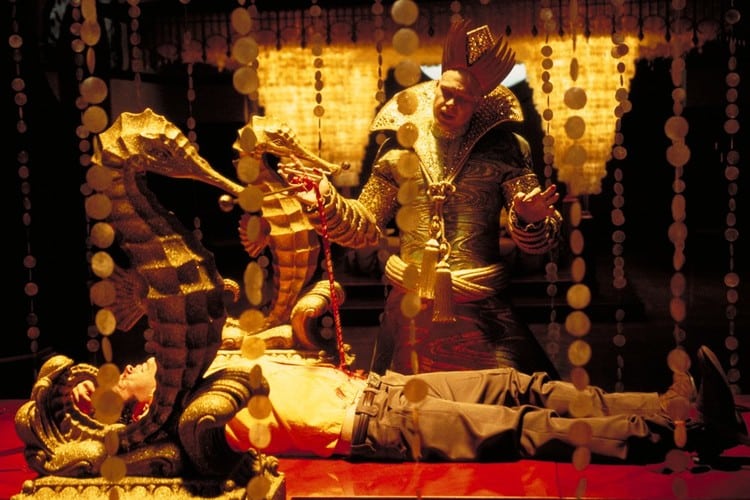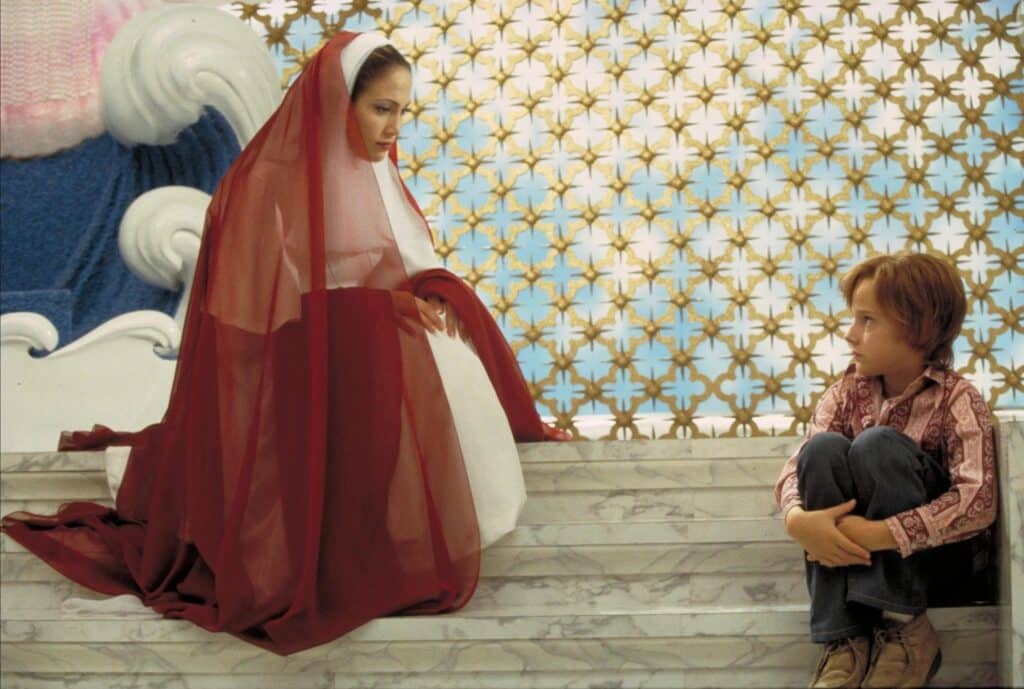Read also:
How to Watch FX Live Without CableHow To Watch AMC Without CableHow to Watch ABC Without CableHow to Watch Paramount Network Without CableTarsem’s sci-fi/horror/serial killer drama suffered from an implausible plot, but remains a feast for the eyes.
Today marks 20 years since the release of The Cell, Tarsem’s very stylish but also very silly high tech serial killer thriller. Megan Sunday and Gena Radcliffe discuss its high and lows.
GENA: Hey, Megan? Remember music videos? Those were great. Not only were they art forms in and of themselves, often their directors went on to successful careers in feature films. Sure, there’s the obvious, like David Fincher and Spike Jonze, but we can’t forget the also-rans, like the singularly-named-like-Cher Tarsem. I don’t know if this counts as a Mandela Effect sitch, but if you asked me before I looked it up how many music videos Tarsem directed, I would have guessed somewhere between fifteen and sixty. The number is four, and two of them barely saw any play on MTV. What matters is that he directed the video for R.E.M.’s “Losing My Religion,” arguably one of the most iconic music videos of the 90s. As opposed to videos of the 80s, which were often literal interpretations of song lyrics (see Devo’s “Whip It”), 90s videos were more art and image driven, and had little to do with the songs themselves at all. That was due to Tarsem’s elliptical style.
Based largely on the success of one (1) music video (though granted it was an extremely successful video), Tarsem was given the opportunity to direct a movie, 2000’s The Cell. Like the video for “Losing My Religion,” The Cell is confounding, often too artsy for its own good, and excessively fetishy, yet it’s full of arresting, unforgettable imagery.
MEGAN: Say, Gena, do you like landscape shots? Maybe with some striking trees and some flowing cloth? Ever see a surrealist painting and think “I’d like to see that in 3D”? Tarsem not only knows that we all like those things, but also how to create them; the problem is that The Cell isn’t the right outlet for his particular brand of showmanship. It’s a weird and nasty little serial killer adventure that suddenly blazes into color and symbolism, but never quite puts it all together into a cohesive movie. This movie is filmed like they promised Tarsem he could do what he wanted for exactly half of it.
GENA: The first thing you need to know about The Cell, other than all the weird shit (which we’ll get to), is that almost every single actor in it, with the possible exception of Dylan Baker, who plays his usual “soft-spoken white collar professional” character, is woefully miscast. Jennifer Lopez is unconvincing as a psychologist. Vince Vaughn is even less convincing as an FBI agent.
The Cell is confounding, often too artsy for its own good, and excessively fetishy, yet it’s full of arresting, unforgettable imagery.
MEGAN: I mean, the dog is doing strong work, and Patrick Bauchau plays…a coldly elegant European gentleman. Serial killer Carl Stargher is a role Vincent D’Onofrio could do in his sleep; luckily he was almost custom-made for Carl in his dream demon form. Vince Vaughn is floundering from the word “go.” He has a lengthy monologue to Jennifer Lopez’s Catherine that’s supposed to give us insight into his secret pain and the horrible reason he became an FBI agent. Instead you can almost see Lopez’s eyes glaze over as he rambles on and on about a child murder that he’s somehow made boring. There are several of these exposition dump conversations and you can’t help but picture Tarsem behind the camera like “Sure, that’s fine, when are we back in that H.R. Giger hallway set?”
GENA: Written by Mark Protosevich, The Cell has a plot that seems like it germinated from a late-night-while-very-high conversation in a college dorm: “Dude. What would it be like if we could…”**massive bong hit**”Go inside other people’s subconscious minds?” Here, it’s some sort of nonsensical technology that allows people to enter the minds of comatose patients and force them to wake up from the inside, when poking them in the toe with a needle doesn’t work. It would take several more bong hits to get into the ethical issues of entering someone’s mind without their consent, but those are summarily ignored here.
MEGAN: Catherine, who can go into comatose patients’ minds as long as she’s wearing an artisanal bodysuit and injected with the right drug cocktail, reluctantly agrees to try the technique with Carl, who’s fallen into a coma after leaving a victim slowly drowning in his elaborate death machine. And Carl’s mind is a doozy.
GENA: As much as Hollywood loves a good dream sequence, they rarely resemble the mundane “oh no I’m late for the big math final and I forgot to wear shoes” reality of dreaming. My dreams are very vivid, and occasionally defy explanation, but they’re always rooted in boring everyday life, set in airports and hotels where I can no longer remember how an elevator works.
MEGAN: I once dreamt that I was in a perfectly normal McDonald’s and then a fish swam by my head. That’s it.

GENA: In The Cell, Carl’s dreams (disregarding the question of whether or not comatose people can dream) are baroque set pieces, mixing BDSM with religious imagery and heavily influenced by the aforementioned H.R. Giger, British artist Damien Hirst, and Marilyn Manson videos. Carl dreams of himself not just as a sadistic mad genius, but as a literal demon king, who has horns in one scene, and wears a bejeweled cape that looks like it was purchased from the Liberace Collection in another. With all that, and the nipple piercings, and the leather pants, and the occasional vampire contact lenses, you’d think the character would be ridiculous, and yet…D’Onofrio pulls it off.
Megan, I’m just gonna say it. With the possible exception of his role in Mystic Pizza, where he does not play a serial killer, Vincent D’Onofrio has never looked hotter. If you’ve ever had complicated feelings about movie villains, The Cell is the movie for you.
MEGAN: “If”? That aside, that’s incredibly true, Gena. Dream Demon King Carl is a looming, prancing, manifestation of dark sensual evil, a figure of dripping menace who also happens to have the face of an early-Aughts Vincent D’Onofrio. If my overuse of adjectives isn’t making it obvious, Carl’s dream world is the place where complicated feelings come from. Much like Lili in Legend, won over at the end of her rope by cinema’s best goth dress, it’s easy to be seduced by the surreal glamour and let oneself (as Catherine does) forget the darkness underneath. Or maybe that’s just me.
GENA: It’s definitely not just you.
MEGAN: The problem with The Cell is that you remember all of the imagery and none of the plot, and the plot turns out to be a big *shrug*. It makes it tough to parse out if this is actually a good movie at all. The FBI real world portions are somehow dull despite the subject matter. Carl is such a hodgepodge of “serial killer stuff”: there’s weird religious stuff, abuse, creepy sexual abuse stuff, he hates women, he likes hooks and pain and ritual masturbation, and it starts to feel like someone used a Serial Killers for Movies checklist. Yes, a person like Carl would likely see himself in his dreams as a larger-than-life persona, but does he have to be so very much in real life too? Even his method of murder is an over-the-top death machine in a top secret murder complex; like every serial killer to grace a screen since 1995, it’s all overdone.

GENA: I will say that for all its excess, The Cell is owed a great debt by TV’s Hannibal. Both deal in dodgy-at-best psychology, and outlandish horror tableaus that are both hilariously over the top, and yet undeniably stick with you. Hannibal even lifted an image from The Cell, when a character is sliced into several pieces and set up as gigantic anatomy slides. Where Hannibal is superior to The Cell is its total commitment to being weird and uncomfortable at all times, whereas The Cell often feels like two different movies mashed together to diminishing results, hampered by an oddly uplifting ending.
MEGAN: Gena, under no circumstances can you let me forget that this movie climaxes on the set of the Erasure video for “Always.” Catherine, having been released from Carl’s mind prison by Peter (Vaughn) who hastens off to release Carl’s victim, decides to try the previously-forbidden technique of bringing Carl into her mind so that she can control things. She creates a glowing snow-covered garden with flowering trees and a koi pond so that she can try and comfort Carl’s inner child because she just can’t let a child suffer, even a child who doesn’t really exist.
GENA: Yeah, “Catherine just needs to get in touch with the wounded little boy inside of Carl the psychosexual maniac” is what takes The Cell from “this is interesting” to 1-800-COME-ON-NOW. Consider how often “he was abused as a child” goes over as an excuse in real life serial killer trials, and you’ll understand why this third act “Catherine as holy savior” twist doesn’t sit well. It’s the same reason that the climax of It: Chapter Two, when the Losers’ Club turns Pennywise into a tiny version of himself, doesn’t work: you don’t suddenly make the audience feel sympathy for someone who’s caused so much horror and pain.
MEGAN: Mommy issues? Madonna/Whore issues? All of the above? Who cares, Catherine saves the day by “freeing” (killing) Kid Carl and I guess is now a super psychologist who can just bring all her patients into her mind palace and heal them. Oh, and the FBI has decided that Dylan Baker fed Peter some LSD and he hallucinated the whole trip inside of Carl’s mind and they solved the case using detective work. The end. …Okay? What? Given that the movie ends with Catherine creating another dream vista to help a patient, Tarsem wanted to end with a showpiece and the plot, as per normal, is an afterthought.
GENA: ALL THAT BEING SAID, on visual appeal alone, The Cell is probably among the most gorgeous movies of the 00s (the most gorgeous is 2006’s The Fall, which, not coincidentally, was also directed by Tarsem). It’s not the dumbest plot involving serial killers and technology — that would be 1995’s Virtuosity, which doesn’t even have the decency to look cool. And I cannot overstate how weirdly, inexplicably attractive Vincent D’Onofrio is in it, even if he occasionally looks like he’s on his way to a Skinny Puppy concert. It’s a movie strictly for the eyes, and not the brain, and in this case that’s enough.